
Youth Activism and Grief on Earth Day
Earth Day—which takes place each year on April 22—is a meaningful time for educators to consider the ecological issues facing the planet and the unique ways that they are impacting the young people in their classrooms. Though we have seen considerable and ongoing action from young people concerned about ecological destruction, young people are also bearing the brunt of what is being increasingly described as “ecological grief”—a term used to describe feelings of loss and sadness caused by present or future barriers to meeting basic needs; the disruption of cultural practices and knowledge related to the natural world; and a host of other changes in the environment. This Earth Day, educators have an opportunity to both elevate the activism of young people challenging ecological destruction while also exploring how to hold space for young people to feel and process the wide range of emotions that these issues are eliciting.
There are a great many young climate activists that educators might choose to elevate in the classroom and they hail from all over the world. Though Swedish teenager Greta Thunberg has become one of the most visible climate activists on the global stage, there are numerous young figures leading this work within the United States. Among them is Xiuhtezcatl Martinez—a 21-year old Indigenous climate activist and music artist from Boulder, Colorado who has been working on behalf of the environment for over a decade. In addition to serving as a plaintiff in a fracking-related lawsuit in Colorado beginning in 2020, he has also been instrumental to a historic, youth-led lawsuit against the U.S. government.
Starting in 2015, Martinez joined with fellow youth collaborators and Earth Guardians—a global environmental advocacy organization for which he served as Youth Director—and filed a constitutional climate lawsuit that would become known as Juliana v. United States. In this case, Martinez and the other plaintiffs have asserted that the U.S. government’s actions have violated young people’s constitutional rights, including those to life, liberty, property, and the protection of essential public trust resources. After nearly seven years of ongoing legal struggle, the plaintiffs continue to fight—but as various forces inhibit the legal and ecological shifts they are seeking, the future for which Martinez and his collaborators are fighting remains uncertain.
This paradoxical combination of continued struggle against ecological harm and awareness that we are, in some sense, failing to meaningfully curb its continuation is among the factors that is giving rise to what has been termed “ecological grief.” Though recent reporting reveals that young people are facing a host of unique threats to their mental health, this phenomenon of ecological grief is a significant source of distress that is not to be overlooked. Even as various groups of people young and old push for policy transformation, the notion that it may be too late—either for residents of particular parts of the world or for humanity on the whole—seems to be gaining currency in certain quarters.
The task of navigating the resulting array of hopes, fears, convictions, immense losses, and inequities in the classroom is inherently difficult, but these issues are poised to become increasingly prominent in the minds and lives of the young people we serve.
With these considerable challenges in mind, Facing History invites educators to use our Teaching Idea Reflecting on Climate Change and Ecological Grief which is designed to help students reflect on their emotional reactions to climate change, consider their connection to the natural world, and consider how collective action against climate change can make a difference.

